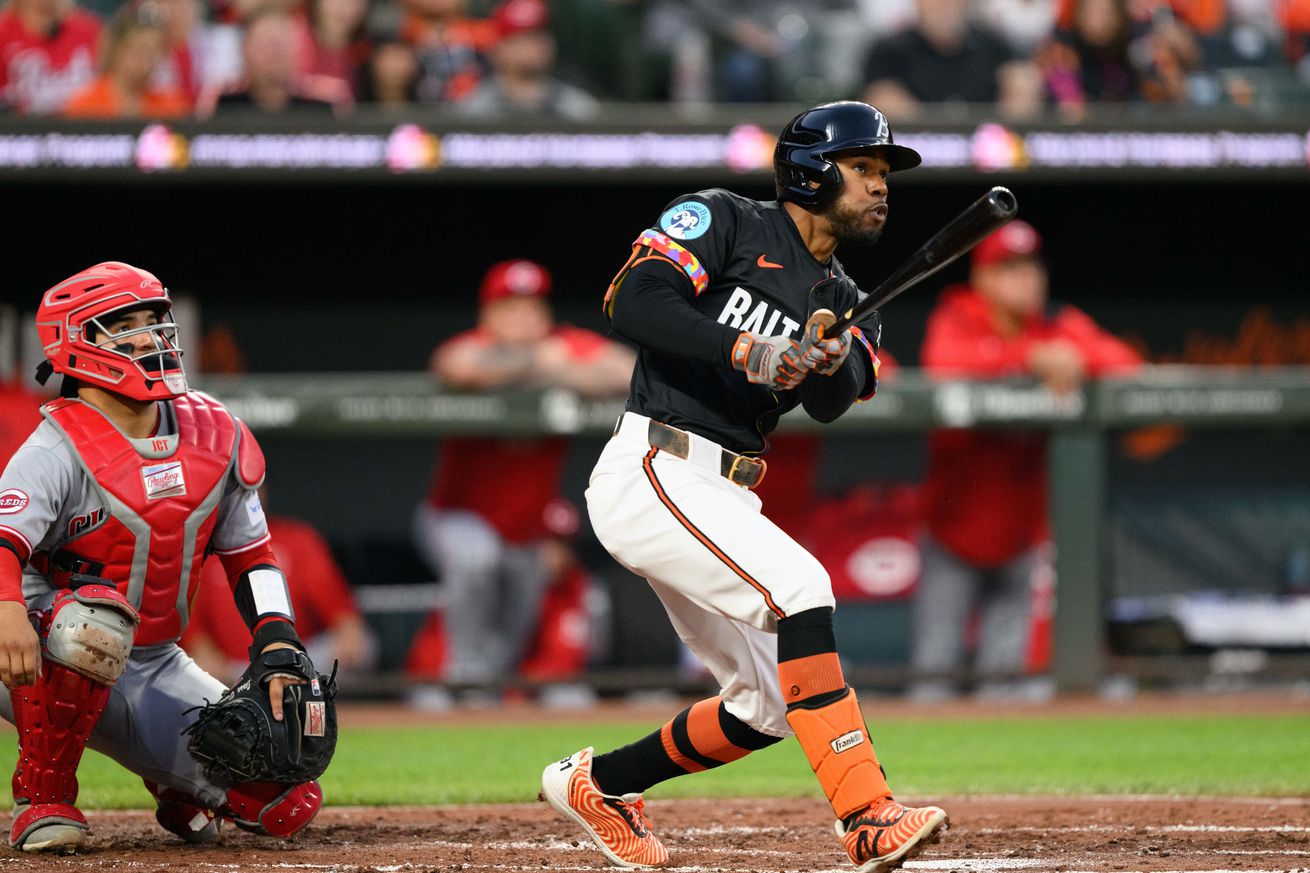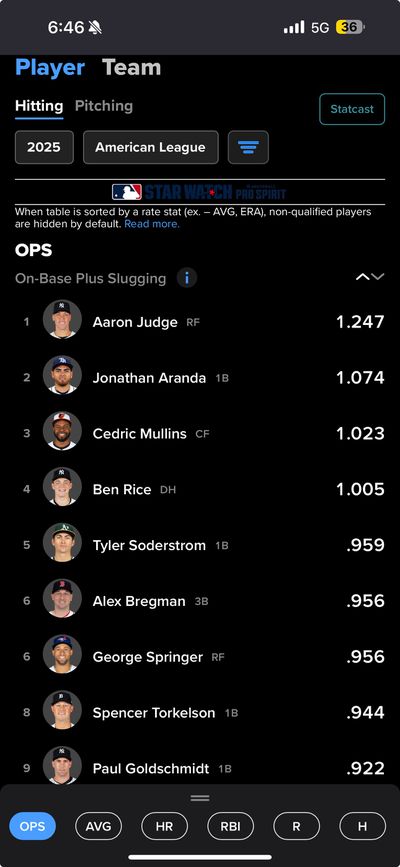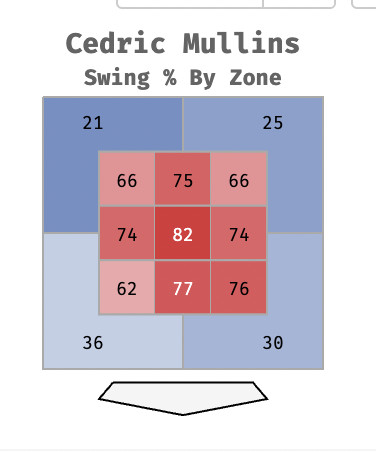
In a plenty frustrating season so far, let’s focus on one positive: a banner start for the O’s veteran center fielder.
When it comes to what’s not working for the Orioles right now, there’s plenty to discuss. They’re on pace for 67 wins, their worst finish since 2021, their starting rotation is the worst in baseball and, I learned last night from Tyler Young, until Thursday the team hadn’t won a single game in which they’d scored less than five runs. The young position player core—Gunnar Henderson, Adley Rutschman, Jordan Westburg and Jackson Holliday—isn’t hitting. Even the defense, supposed to be a strength, has been unexpectedly sloppy. The O’s have been tough to watch this month of April.
For what it’s worth, I don’t think the team is as bad as it’s playing right now. I expect things to get better as the youngsters bust out of their slumps and pitchers return from injury. But for those of us who require more immediate sources of gratification, let’s talk about one Oriole who, unexpectedly, is greatly outperforming expectations: center fielder Cedric Mullins.
Being underestimated is nothing new for the Campbell U. Fighting Camels alum, a 13th-round pick for the Orioles in 2015 who was once optioned during the season, not just down to Triple-A but down another level to Double-A after that, because he was hitting so badly. Mullins has dealt with low expectations before, and pushed past them.
So far we’re barely a month into the 2025 season, but what a month it’s been for Mullins. In 93 plate appearances, the O’s CF has a .295 average, .441 OBP, and 1.023 OPS—which, to put in context, see the chart below. He’s hit six home runs and is walking at a career-best rate. He’s not just leading his team in WAR, he’s second in the AL in WAR to only New York’s Aaron Judge, too. Mullins is far-and-away the Orioles’ offensive leader right now and this, we should add, is especially tough to do when a lot of the lineup is slumping.

As Fangraphs’ Michael Baumann wrote recently (no, not that one), “we’re coming up on a month’s worth of information here, which is enough to know that Mullins is actually doing something different in 2025.”
According to Baumann, one thing standing out about Mullins right now is that he’s playing “a bigger man’s game.” This is a fun thought. As you might know, Mullins is only 5-foot-8, and coming out of college he profiled as a “slap-and-run” hitter with speed but not much pop. Over his first three years in the majors, he certainly played this way, posting a hefty 48.7% groundball rate and a rather low 27.5% hard-hit rate.
But he’s certainly found his power now. Mullins’ ISO (a measure of isolated power) is a career-high .333, tenth-best in all of baseball and well above his All-Star season’s rate of .228. Furthermore, because he’s pulling the ball and hitting it in the air, he’s thus more likely to drive it far—this makes sense, right? Mullins’ in-air pull rate of 30.2% is almost five percentage points better than his previous career high and nearly double the league average. The 5’8” Mullins, in other words, has become a slugger.
Mullins’ career totals show that this didn’t happen overnight. The outfielder started finding his power in 2021—no coincidence, the same year he stopped switch-hitting (<3 always, Buck Showalter). That year, for the first time, Mullins hit more fly balls than grounders. Interestingly, the trend has continued every year since. From a high of 50.9% in 2019, Mullins’ ground ball rate dropped to 38.6% in 2021, 34.5% in 2023, and a career-low 26.3% so far this season, the fifth-lowest rate out of all qualified hitters. Interestingly, this is true despite the fact that Mullins’ hard-hit rates went up between 2019 and 2021, then dropped from 2022 to 2024, and are now back up to close to what they were in his All-Star 2021.
Repeatability and small sample sizes are, of course, an issue. Mullins won’t hit 44 home runs (his current pace). And it’s true, he does seem to see the ball well in the spring. On the other hand, one thing he’s doing to contribute to the sustainability of this effort is make good swing decisions.
Mullins is absolutely crushing it in the walks department right now. His walk rate of 19.3% is more than twice his best effort from any other year, and third-best of all qualified hitters. He’s swinging at fewer balls outside the strike zone than ever, and is swinging more choosily, period.
You can see this clearly in his Statcast Zone Swing Percentage charts from last year and now. The most interesting quadrant is the upper-middle portion of the strike zone. Whereas Mullins swung at 75% of those pitches in 2024, he’s cut that rate to 47% in 2025. It seems to be working for him. Maybe when you’re 5’8”, umpires call that pitch a ball.


It’s not just the top of the zone but the bottom, too. Last season, swinging over the top of breaking balls was a huge weakness for him, with a .164 average and 19.1% whiff percentage on these pit. This season, he’s laying off balls in the bottom of the zone, especially ones low and away. And he’s hitting breaking balls better than he ever has in his career (including 2021), with a .294 average against and a puny 4.7% whiff percentage.
Meanwhile, Mullins’ value to the team feels greater than ever in ways quantifiable and not. The Orioles are struggling against left-handed pitchers, and Mullins continues to defy the best wisdom of the platoon crowd, with a .389 average and 1.320 OPS against southpaws. Not only that, with young Orioles stars like Gunnar, Adley and Jackson Holliday stuck in the skids right now, Mullins is a potential voice of wisdom. He told MASN recently, “For a guy like me to have been in the minor leagues for some time, gone through struggles in the minors, gives you an idea of how to adjust when you’re in the bigs. For these young guys that have been damn good for their entire careers, up until … now, it’s just trying to make sure that they continue to have a positive mindset.”
Mullins’ success so far and value to the team give an ironic quality to the fact that the Orioles haven’t made any progress toward an extension. When asked whether he wants to resign with Baltimore, Mullins replied, “Yeah, 100%.”
You could argue that a 30-year-old center fielder will have diminishing value in his upcoming seasons. But center fielders with range, speed, and who can actually hit for power aren’t a dime a dozen. If the Orioles aren’t willing to extend a multi-year contract to Cedric Mullins, some other team will.